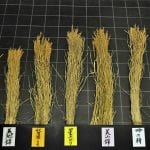This article was originally published in Sake Industry News #5 Interested in more info like this? Subscribe, and enjoy your first two issues (and access to all back issues!) for free! https://sakeindustrynews.substack.com/
 Studying rice varieties in excessive detail can be of dubious value. I say this because, as we all know, although the choice of rice strain is extremely important in brewing good sake, brewing methods, technology and the brewer’s skill are also of paramount importance. Which is more important? The answer to that is: all of them.
Studying rice varieties in excessive detail can be of dubious value. I say this because, as we all know, although the choice of rice strain is extremely important in brewing good sake, brewing methods, technology and the brewer’s skill are also of paramount importance. Which is more important? The answer to that is: all of them.
Setting that paradox aside, some rice strains – especially some of the “pure” strains – can be great fun and extremely interesting to study. So in that light, let us look in some detail at one of the most storied rice strains in use today: Omachi.
Currently, Omachi is the fourth most widely grown sake rice, behind the ubiquitous Yamada Nishiki, Gohyakumangoku, and Miyama Nishiki. It is also popular among sake fans, to the point it’s become almost cliché to say, “Omachi is my favorite rice.” (But I say it anyway…)
Omachi is a pure rice strain, in that it was not created through crossbreeding between two other strains, as almost all rice varieties in use today are. There are those that use the term “heirloom” to describe such strains, but I tend to shy away from that term since the definition of the word in reference to plant varieties is not clear, and not completely accurate in my assessment. But that is a conversation for another day.
The use of Omachi can lead to very distinctive sake. In short, if brewed to maximize the potential of its characteristics, sake made with Omachi rice will have higher acidity and sweetness, and a noticeable herbal astringency. In fact, “earthy and herbal” rather than “flowery and fruity” describes sake made with Omachi pretty well. A bit of time in the bottle can improve this as well. Also, to me, the overall flavor profile tends to be somewhat textured rather than silky smooth compared to Yamada Nishiki.
But beyond flavor, the history of Omachi is also quite fascinating, so let us take a look at some fun Omachi facts.
Omachi was discovered in 1859 in Okayama Prefecture. It was originally named Nihonsō in 1866, with the name changing to Omachi in 1922 when the government set up a system that included a reproduction process for keeping the lineage of rice strains pure. In fact, almost all Omachi grown today is still grown in Okayama Prefecture.
In 1895, the agricultural research center in Shiga Prefecture took some Omachi that was somehow different enough from the rest of the Omachi they had and renamed it Wataribune. Not surprisingly, different sources say different things, and at least one says that the Omachi grown in Shiga was actually brought up from Fukuoka, meaning it likely made its way via Okayama first. So, some say that Omachi and Wataribune are the same, others say that is not really true. I think it is more likely to be true, but you make the call.
Next, someone took this Wataribune rice and selected seeds from the shortest of the lot to grow again next year, in order to make it easier to harvest – kind of Darwinism in reverse. Why would they do that? Because if the rice stalks are too tall, they fall over before being ready for harvest, which can lead to germination resulting in the rice becoming unusable for brewing. This is one of the drawbacks of Omachi: it has tall stalks and is difficult to grow. This shorter variation of Wataribune became known as Tankan Watribune (short-stalk Wataribune).
Almost all sake rice grown today is a result of crossbreeding, and Omachi is in the roots of about 60 percent of all sake rice. There are a handful of variations of Omachi that are slightly different based on where they are grown such as Bizen Omachi, Akaiwa Omachi, Kairyō Omachi, and a couple more.
As mentioned above, it is the fourth most widely grown sake rice in terms of volume, but the top three are grown in much larger volume, with the gap in volume between Miyama Nishiki and Omachi being significant. Yamada Nishiki is grown in volumes somewhere around ten times that of Omachi.
One more anecdote: Long ago, several strains of Japonica rice were brought over to the USA by Japanese folks that emigrated there. Records show that one of these varieties was Wataribune (AKA Omachi), which back then was also used for eating. That Wataribune was crossbred again across several generations with a handful of other rice strains and today is known as Calrose. A large percentage of sake produced in the USA is made using Calrose rice, which is also used for eating in the US. However, it no longer resembles its venerated ancestor, making it a bit of a stretch to say Omachi lives on in the US.
So, in review: Nihonsō = Omachi = Wataribune = Tankan Wataribune = one of the parents of Yamada Nishiki. Or at least, that’s pretty close to the facts.
Obviously, not all sake rice has such a colorful ancestry, nor so many famous relatives. Most, in fact, have much fairly uninteresting developmental backgrounds, making it all the more important to convey the history of the more interesting examples such as Omachi from Okayama.
Interested in more info like this? Subscribe, and enjoy your first two issues (and access to all back issues!) for free! https://sakeindustrynews.substack.com/





